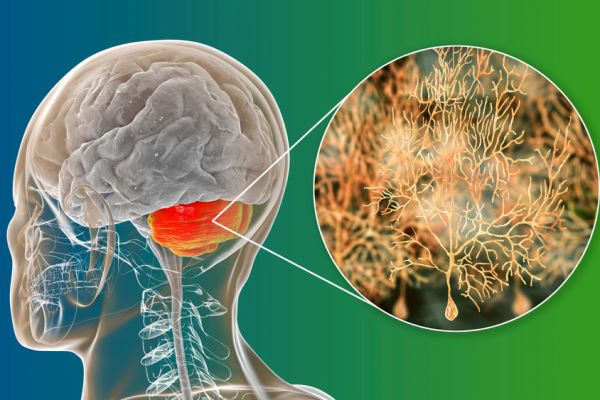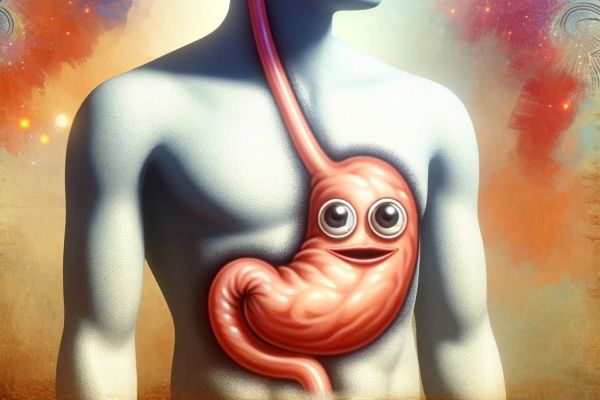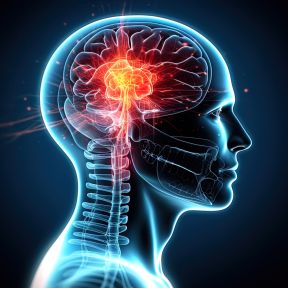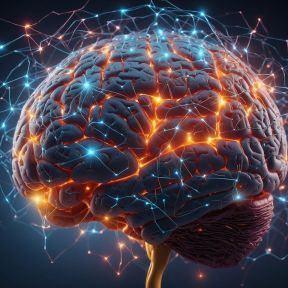Brain Disease and Injury
The depth of the brain’s unconscious, taken-for-granted functions and complex conscious abilities comes into sharp relief when they are disrupted in cases of brain disease and injury. Whether the damage unfolds in slow motion over the course of decades or begins to alter the brain in an instant, the loss or distortion of mental function that neurological conditions can wreak can be life-changing.
That’s why efforts toward prevention, diagnosis, and treatment are so crucial. Many brain diseases cannot be cured, and sudden brain injuries can have lasting effects. But for many conditions, from dementia-causing diseases such as Alzheimer’s disease to traumatic brain injury, scientists and health experts point to ways to promote brain health and reduce risk. And for many conditions, timely diagnosis and intervention may influence the course of the illness and the extent of the long-term harm done.
On This Page
There are hundreds of different diseases that can affect the function of the brain and nervous system, leading to many possible physical, cognitive, and emotional difficulties—from impaired movement or speech to deficits in reasoning, memory, and mood. Some neurologic diseases are present at birth, while many do not manifest until later in life.
Major categories of neurological diseases include:
- Neurodegenerative diseases, which involve the breakdown and death of nerve cells over time. The most common of these are Alzheimer’s disease, marked by a decline in memory and other cognitive functions, and Parkinson’s disease, a movement disorder. The risk of symptoms increases with age, though some conditions that involve nerve cell degeneration, such as Huntington’s disease, are due to a genetic defect. Other degenerative diseases include amyotrophic lateral sclerosis (ALS), multiple sclerosis, and Lewy body disease.
- Stroke, which affects blood vessels that provide blood to the brain, leading to cell death and potentially lasting disability.
- Cancer, which can cause cognitive, movement-related, and other kinds of disability when tumors originate in or spread to the brain.
- Viral or bacterial infection can cause brain inflammation (encephalitis), the symptoms of which can range from flu-like symptoms to severe headache and seizures.
- Diseases due to developmental defects, such as spina bifida, which involves aberrant development of the spinal column before birth.
- Seizure disorders, including epilepsy
See more information on Alzheimer’s disease and Dementia, and on Promoting Brain Health.
Stroke and Alzheimer’s disease (along with other dementias) are among the most prevalent neurological conditions, according to recent research. Global studies have reported about 80 million cases of stroke in a single year worldwide and estimated that nearly 44 million people live with Alzheimer’s disease and other dementias. Tension-type headache and migraine, which are classified as brain disorders but not uniformly considered diseases, were the most common conditions identified.
Major signs of dementia, which can be caused by Alzheimer’s disease or other diseases, include problems with remembering—which may impede everyday activities (such as completing household tasks or getting to destinations)—and other marked declines in thinking and problem-solving. Some people with dementia also show decreased inhibition, including less control of their emotions. Alzheimer’s diseases and other conditions that cause dementia are progressive: Symptoms may become apparent when they are relatively mild and grow increasingly severe over time.
Symptoms of a brain tumor can include cognitive, behavioral, and perceptual problems—such as problems with thinking, remembering, speaking, hearing, or seeing—as well as nausea, vomiting, headaches, and fatigue. The kinds of symptoms that arise can differ depending on the type and location of a tumor. Importantly, there are many other potential causes of each of these symptoms. A doctor can determine whether a tumor is present with an examination and diagnostic tests.
Doctors can diagnose (or rule out) a brain disease through an analysis of a patient’s history, the use of a neurological exam, and a variety of diagnostic tests.
During a neurological exam (or neurological assessment), a doctor may evaluate a person’s movement (including coordination, reflexes, and balance), sensory ability, speech, and other behaviors, and mental status (assessed with questions and cognitive tasks). These evaluations, which may involve tools such as a flashlight and a rubber reflex hammer, help screen for potential signs and symptoms of neurologic diseases.
As part of the diagnostic process, medical professionals may analyze the structure and metabolism of a patient’s brain using brain imaging technologies such as magnetic resonance imaging (MRI) or computed tomography (CT). Other kinds of tests used to diagnose neurologic disease include genetic testing (for genetic causes of diseases such as Huntington’s disease) and screening of blood or other fluids for substances that may indicate infection or other forms of pathology.
Many brain diseases—including Alzheimer’s disease, Parkinson's Disease, ALS, and others—have no cure. However, they can often be treated and the effects managed. For example, treatment with medications can control seizures in many patients with epilepsy and can help reduce symptoms in Parkinson’s disease, diseases that cause dementia, and other conditions, even though these treatments do not completely halt the disease. Medicines, surgery, and other therapies are used to treat stroke and brain tumors.
The risk for many neurologic diseases is affected by a person’s genes. In some conditions, such as Huntington’s disease, the genetic cause is relatively straightforward and a blood test can indicate whether one will develop the disease. For other conditions, the influence of genetics is more complex, but scientists have identified genetic factors associated with increased risk of Alzheimer’s disease, Parkinson’s disease, and others. Even though genes influence a person’s risk of many brain diseases, lifestyle factors like healthy eating and exercise can play a role in reducing risk for some conditions.
Mild Cognitive Impairment is a worsening of cognitive functions such as memory and decision-making with age that is more serious than normal cognitive decline but less so than the decline seen in Alzheimer’s and other forms of dementia. Mild Cognitive Impairment does not necessarily impede daily living, but can in some cases progress to dementia and should be monitored by a medical professional.
Each year, millions of people suffer a sudden blow, jolt, or other impact that impairs the function of their brain. A majority of these brain injuries would be classified as “mild,” resulting in temporary effects on brain function and requiring mostly rest. But more damaging brain injuries can cause extended or permanent difficulties with thinking, communicating, emotion, sensation, movement, and can also be fatal.
Spinal cord injuries, of which there are hundreds of thousands a year, can also have a major impact on nervous system function by damaging the bridge between the brain and the rest of the body. Depending on the severity of the injury, the long-term impact may include partial or total impairment of motor or sensory function below the location of the injury.
For more information, see Traumatic Brain Injury.
Brain injuries occur when a person’s head is struck or jolted, or when it is penetrated by an object (such as a weapon). Common causes of a traumatic brain injury include falls, car accidents, hitting one’s head while playing a sport, and physical assault. Falls are the most common cause of TBI in older adults, while motor vehicle crashes are the biggest cause in young adults. A concussion is a type of brain injury resulting from an impact to the head or body that causes rapid movement of the brain within the skull.
The signs and symptoms of a brain injury depend on its severity. A mild traumatic brain injury may include symptoms such as headache, dizziness, ringing in the ears, difficulty with memory or focus, blurred vision, or fatigue. In some cases (but not all), someone with a mild TBI will briefly lose consciousness. Those with a more severe TBI may experience a persistent headache, nausea, vomiting, seizures, limb weakness or numbness, slurred speech, agitation, or other symptoms, including those present in mild TBI.
A medical professional should be seen immediately if a person’s head has been impacted during a fall or other event and a traumatic brain injury is suspected. A doctor will ask questions about what happened, conduct a neurological exam to check for signs and symptoms, and may use brain imaging or other diagnostic tests to assess the nature and severity of any injury to the brain.
Someone with a mild traumatic brain injury is likely to recover most if not all of their normal brain function within three months of the injury. Still, a period of rest and symptom monitoring, as advised by a doctor, is important. For moderate or severe TBI, the recovery period can be much longer. A more severe TBI will involve more intensive interventions—including initial stabilization and monitoring by medical professionals, potentially followed by surgery and medication as needed—and frequently requires rehabilitation therapy to regain, to the extent possible, skills and abilities that have been impacted by the injury.














